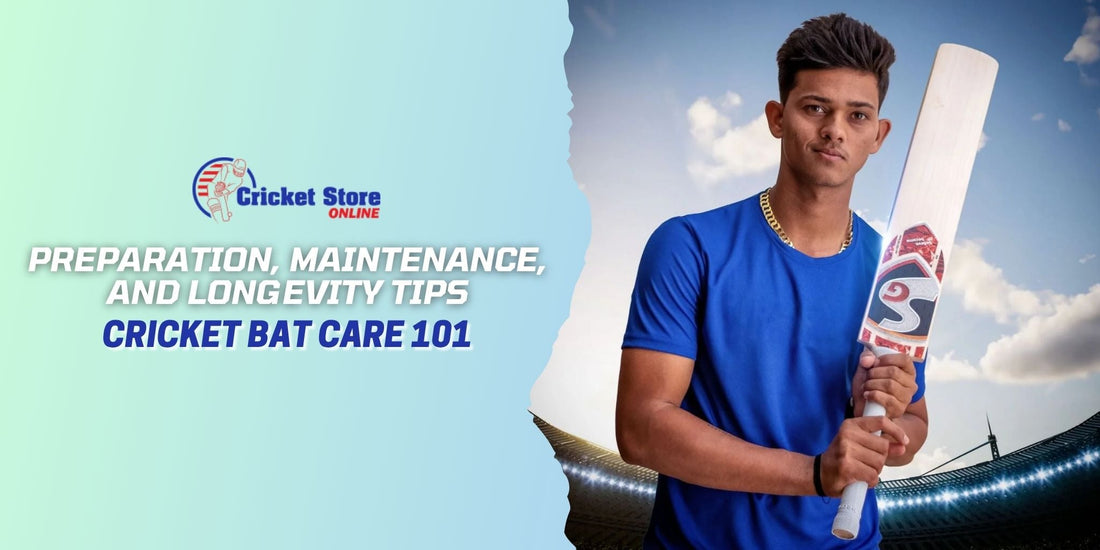Cricket Bat Care 101: Preparation, Maintenance, and Longevity Tips
Proper cricket bat care can transform a decent bat into a long-lasting performance companion that serves you for years rather than months. Many players invest hundreds of dollars in premium cricket bats only to see them deteriorate quickly due to poor maintenance practices. Cricket bat care isn't just about keeping your equipment looking good – it's about preserving the structural integrity, maintaining optimal performance, and maximizing your investment. Whether you're using an English willow Grade 1 bat or a Kashmir willow option, understanding the fundamentals of cricket bat preparation, maintenance, and longevity will significantly impact both your game and your wallet.
Table of Contents
- Understanding Your Cricket Bat: Wood Types and Construction
- Essential Cricket Bat Preparation Steps for New Bats
- Daily Cricket Bat Maintenance and Care Routine
- Seasonal Cricket Bat Care and Storage Tips
- Common Cricket Bat Problems and Repair Solutions
- Cricket Bat Longevity Tips for Maximum Performance
- Essential Tools and Products for Cricket Bat Care
- When to Replace Your Cricket Bat: Signs and Timing
Understanding Your Cricket Bat: Wood Types and Construction
English Willow vs. Kashmir Willow Cricket Bats
The foundation of effective cricket bat care begins with understanding your bat's construction and wood type. English willow bats are crafted from Salix Alba Caerulea, a premium wood that offers superior performance but requires more intensive maintenance. These bats typically feature 6-15 grains per inch and demand careful preparation and ongoing care to prevent cracking and maintain their responsive nature. Kashmir willow bats, made from Salix Alba Kashmir, are more durable and forgiving but still benefit significantly from proper maintenance routines.
English willow bats require oiling every 3-4 weeks during active use, while Kashmir willow bats can go 6-8 weeks between oil applications. The cricket bat longevity of English willow depends heavily on climate control and proper storage, as this wood is more susceptible to moisture changes and extreme temperatures.
Cricket Bat Construction and Vulnerable Areas
Understanding your bat's anatomy is crucial for effective cricket bat maintenance. The toe (bottom edge) bears the brunt of ground impact and yorker deliveries, making it the most vulnerable area for damage. The edges handle the majority of defensive shots and mishits, while the splice (where handle meets blade) endures tremendous stress during powerful strokes. The sweet spot – typically 4-6 inches from the toe – requires careful preservation to maintain optimal performance.
| Bat Component | Vulnerability Level | Maintenance Priority |
|---|---|---|
| Toe | Very High | Daily inspection |
| Edges | High | Weekly reinforcement |
| Splice | Medium | Monthly assessment |
| Face | Medium | Regular cleaning |
| Back | Low | Seasonal inspection |
Essential Cricket Bat Preparation Steps for New Bats
Cricket Bat Knocking-In Process
Proper cricket bat preparation is non-negotiable for new bats, regardless of grade or price point. The knocking-in process gradually compresses the wood fibers, creating a harder, more responsive playing surface while reducing the risk of cracks and splits. Learn the essential steps for cricket bat preparation to maximize performance through a systematic approach that typically requires 6-8 hours of dedicated work spread over several days.
Begin with a cricket bat mallet or old cricket ball, starting with gentle taps across the entire face, paying particular attention to the edges and toe area. Gradually increase the force over multiple sessions, allowing the wood fibers to compress naturally without shocking the bat. Understand why knock-in a cricket bat is crucial and how to do it right – this process literally determines whether your bat will last months or years under regular use.
Oiling Your Cricket Bat for Optimal Performance
Cricket bat care requires understanding that willow is a living material that needs moisture to maintain flexibility and prevent cracking. Apply linseed oil sparingly using a clean cloth, focusing on the face, edges, and toe while avoiding the splice area. Over-oiling is more dangerous than under-oiling, as excessive moisture can make the wood soft and prone to denting.
New bat oiling schedule:
- Day 1: Light application across all surfaces
- Day 3: Second light coat focusing on edges and toe
- Day 7: Final preparation coat before knocking-in begins
- Ongoing: Every 3-4 weeks during active use
Edge and Toe Protection During Preparation
Discover how to protect cricket bat with anti scuff sheets for longer life by applying these protective materials during the preparation phase. Quality anti-scuff sheets create a barrier against abrasive surfaces while allowing the wood to breathe naturally. Focus protection on the most vulnerable areas: toe guard installation prevents ground damage, while edge tape reduces the impact of defensive shots and mishits.
Daily Cricket Bat Maintenance and Care Routine
Post-Practice Cricket Bat Care Checklist
Implementing a consistent daily cricket bat maintenance routine separates bats that last seasons from those that deteriorate within months. After each practice session or match, inspect your bat for new marks, cracks, or areas of concern. Remove any dirt or grass stains using a barely damp cloth, ensuring no moisture penetrates the wood grain. Check the protective tape and sheets for wear, replacing them before they become ineffective.
Daily inspection points:
- Face condition and new ball marks
- Edge integrity and protective tape status
- Toe guard security and wear patterns
- Handle grip condition and binding tightness
- Overall feel and sound when tapped
Allow your bat to air dry naturally if it has absorbed any moisture during play, but avoid direct sunlight or heat sources that can cause rapid moisture loss and cracking. Store the bat in a cricket bag with proper ventilation rather than sealed containers that trap humidity.
Seasonal Cricket Bat Care and Storage Tips
Cricket Bat Care During Playing Season
Active season cricket bat care requires balancing performance maintenance with protective measures. Weekly deep cleaning removes accumulated grime and allows for thorough damage assessment. Apply fresh oil every 3-4 weeks for English willow, adjusting frequency based on usage intensity and environmental conditions. Rotate between multiple bats when possible, giving each time to rest and recover between intensive use periods.
Monitor your bat's performance indicators throughout the season: reduced sweet spot responsiveness, increased vibration on contact, or changes in the sound when tapping the blade all signal the need for maintenance attention or potential replacement consideration.
Off-Season Cricket Bat Storage and Maintenance
Proper off-season storage can extend cricket bat longevity by years. Clean your bat thoroughly, apply a light oil coat, and store in a temperature-controlled environment between 60-70°F with 40-50% humidity. Avoid basements, attics, or garages where temperature fluctuations can cause wood movement and cracking.
Storage checklist:
- Clean and lightly oil all surfaces
- Remove and replace protective tape if worn
- Store vertically with toe down or horizontally with support
- Check monthly for any signs of movement or cracking
- Maintain consistent temperature and humidity
Common Cricket Bat Problems and Repair Solutions
Identifying Cricket Bat Damage Early
Early damage detection prevents minor issues from becoming major problems requiring expensive repairs or replacement. Hairline cracks often appear first at stress points like the toe or edges, while dead spots develop gradually as wood fibers compress unevenly. Listen for changes in the bat's sound when tapped – healthy willow produces a clear, resonant tone, while damaged areas sound dull or muffled.
Read our cricket bat repairs blog for tips on fixing and maintaining your bat to understand when DIY solutions are appropriate versus when professional intervention becomes necessary. Minor surface scratches and small edge chips can often be addressed at home, but cracks extending more than 2 inches or penetrating deeply into the wood require expert attention.
Cricket Bat Longevity Tips for Maximum Performance
Usage Rotation Strategies
Professional players often maintain 3-4 bats in rotation, using different bats for nets, practice matches, and important games. This rotation strategy allows each bat adequate recovery time while ensuring you always have a backup option available. Designate specific bats for different purposes: a heavily knocked-in bat for facing fast bowling in nets, a match bat for important games, and a backup option for casual cricket.
Rotation benefits:
- Extended individual bat lifespan
- Consistent performance availability
- Risk management for important matches
- Better overall value from equipment investment
Playing Surface Considerations
Different playing surfaces affect cricket bat maintenance requirements significantly. Artificial pitches tend to be more abrasive and require frequent protective tape replacement, while natural grass wickets are generally gentler on equipment but may present moisture challenges. Adjust your post-game care routine based on conditions: extra cleaning after dusty grounds, thorough drying after damp conditions, and increased edge protection for abrasive surfaces.
Essential Tools and Products for Cricket Bat Care
Must-Have Cricket Bat Maintenance Kit
Building a comprehensive cricket bat care kit ensures you're prepared for all maintenance scenarios. Essential items include linseed oil (raw, not boiled), anti-scuff sheets, edge tape, a cricket bat mallet, sandpaper (fine grade), and cotton cloths for cleaning and oil application.
| Tool/Product | Purpose | Replacement Frequency |
|---|---|---|
| Linseed Oil | Wood conditioning | Every 6–12 months |
| Anti-scuff sheets | Surface protection | As needed |
| Edge tape | Impact protection | Monthly during season |
| Cleaning cloths | Maintenance | Every 3–6 months |
| Sandpaper (400+ grit) | Surface preparation | As needed |
Recommended Cricket Bat Care Products
Quality matters significantly in cricket bat maintenance products. Raw linseed oil penetrates wood effectively without leaving residue, while marine-grade anti-scuff sheets provide superior durability compared to generic options. Invest in professional-quality edge tape that maintains adhesion under stress and temperature variations.
When to Replace Your Cricket Bat: Signs and Timing
Performance Indicators for Bat Replacement
Recognizing when cricket bat replacement becomes necessary prevents frustration and potential injury from equipment failure. Sweet spot deterioration manifests as reduced power transfer and increased vibration, while structural integrity loss appears as visible cracks, edge damage, or handle loosening. When maintenance costs approach 50% of a replacement bat's value, or when performance degradation affects your game significantly, replacement becomes the logical choice.
Replacement indicators:
- Multiple cracks requiring professional repair
- Sweet spot has shifted or diminished noticeably
- Edges are severely damaged despite repair attempts
- Handle has loosened beyond simple retightening
- Overall performance no longer meets your standards
Economic Factors in Cricket Bat Replacement
Smart cricket bat care includes understanding the economics of maintenance versus replacement. Track your maintenance costs, including time investment, and compare against replacement options. Sometimes, investing in a higher-grade bat with better longevity characteristics proves more economical than repeatedly repairing lower-quality equipment.
Mastering cricket bat care through proper preparation, maintenance, and longevity strategies transforms your relationship with your equipment from constant concern to confident reliability. The investment in time and attention to proper cricket bat maintenance pays dividends through extended equipment life, consistent performance, and reduced replacement costs. Whether you're maintaining a premium English willow bat or caring for a reliable Kashmir willow option, these comprehensive care principles will ensure your cricket bat serves you well throughout many successful seasons. Remember, a well-maintained bat isn't just equipment – it's a partner in your cricket journey that deserves the same attention and respect you give to your technique and fitness.


